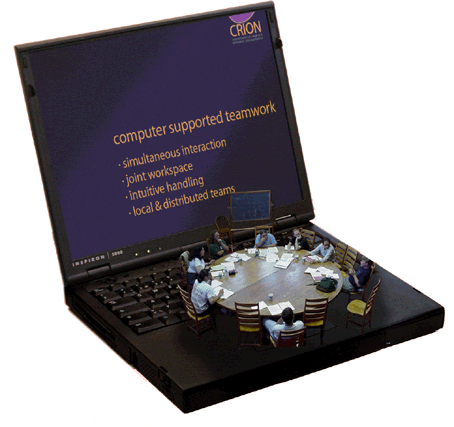CRiON
Overview

While in former times the genius and the creativity of an engineer was the guaranty for the success of a new product, today's innovation cycles, the high dynamics of the market and interdisciplinary problems require more efficient planning and designing processes. Especially in the early stages of the product development process an interdisciplinary teamwork is required, which can be successfully supported by creativity methods. These methods require a lot of communication and also a spontaneous, parallel working, which are up to now not supported by today's information technology. Creativity processes use methods that are based on writing on paper. This causes a break in the logical workflow since all later processes are digitally supported. This break in the used media causes exhaustive data conversions and data reconstructions.
Within this project a new interaction technology will be developed after an introductory literature research. This new technology should allow a simultaneous intuitive interaction of up to six users with a computer. Based on this technology a digital workspace for small groups will be designed, which can be used as an individual workplace but also be interconnected with other workplaces over a network.
Already existing creativity methods will be evaluated whether they could transferred into a digital environment. New methods will be developed that take full advantage of this new digital environment and that can be only be used within this digital environment. The newly developed methods will be together with the adapted methods in this new environment and will be tested together with industry for their efficiency and their acceptance.
Motivation
In the sixties creativity was regarded as an optimizing property within work processes and as an optimal behavior to solve problems.
However, it became clear very fast that creativity has to be regarded more generally and that it cannot be predicted nor forced. Creativity was defined by Carl L. Rogers as the natural behavior of a living organism. Creativity occurs if this organism is open to all inner and outer experiences and when is free to try all different relationships in a flexible way.
In order to reach creativity the necessary prerequisites have to be fulfilled and a special atmosphere has to be created. Many special environments were created for “creativity“, where persons could work without any distortions from outside. In order to perform creativity processes with multiple persons in a successful way, different methods and tools were developed within the past 30 years, which use the so-called synergy effect of interdisciplinary teams and lead to unique and surprising results. A lot of these creativity methods proofed many years, they were further developed and are still very effective and frequently used.
Unlike many other processes, which are very well supported by information technology, creativity processes are performed in an analog, e. g. paper-based, way. Thus taking the protocol and preparing the data for further processing is very exhaustive and very often important information is lost.
The reason that creativity processes are not supported very well by the computer is in the way of using today's computer. The only possible interaction is with mouse and keyboard and the data are displayed on a screen. This way of interaction suits for the individual user and only for a text-based work, which is logically structured. However, this clearly contradicts to the requirements for a collaborating group and does not create this special atmosphere that is required for creativity.
During the last months a lot of technologies were announced and already sold, which allow an intuitive entering of text into various input devices like computer, PDA, organizer and cellular phone. Thus various “digital“ pencils exist, which can be used to transfer handwritten notes on the paper via infrared and/or ultrasound technology digitally to the connected computer system. Tablet PCs are available since November 2002, which use the new operating system Windows XP for tablet. These ultra compact notebooks can be controlled completely without any keyboard and they could open new application fields.
These new interaction technologies show that there are other useful interaction technologies for a computer beside mouse and keyboard. However, these technologies are mainly designed for a single user and do not support teamwork in a meaningful way.
Since the available hardware does not support the interaction in a group, there was no research or development for software that supports creativity processes in a team. Various research institutes and companies presently work on CSCW (computer supported collaborative work), but mainly focus on a teamwork with networked team members. Individual workplaces that interconnected over a network allow a collaborative work of the individual team members. The common application (groupware) allows the common usage and administration of data and support the communication and the project planning. However, an effective teamwork of a local or a networked team is not supported.
In order to perform creativity processes in the used way or in a similar way and to support them with information technology, new interaction technologies are required, new software is needed and also new methods have to be created or old methods have to be adapted.
The visualization of ideas or proposals of ideas plays an important role in creativity processes, especially in the early stages of the development process. Thus there must be the possibility for a common sketching or editing by a single person but also in a team, being physically present in the same room are distributed in a network. This must be as intuitive as archiving data and the management of this non-text data.
The goal of the project is to develop an interaction technology that allows the intuitive use of information technology by smaller groups. A prototype of that new workspace will be built in order to evaluate adapted or newly developed creativity methods and the evaluate the efficiency and the acceptance of a digital system to support creative teamwork.







